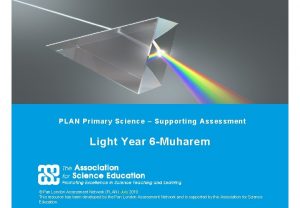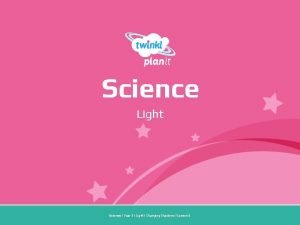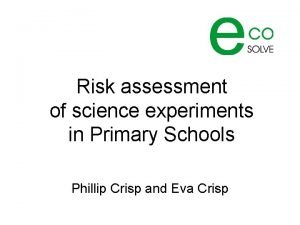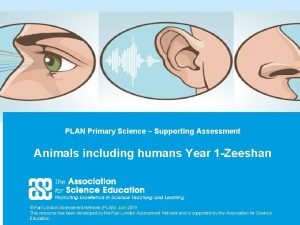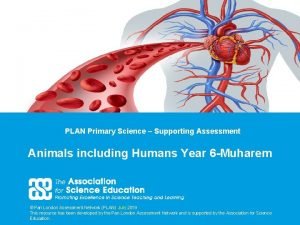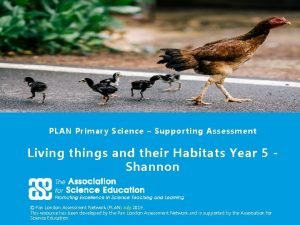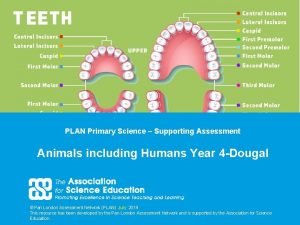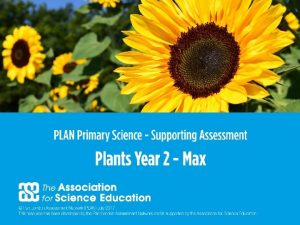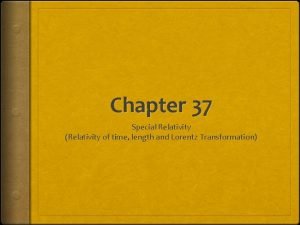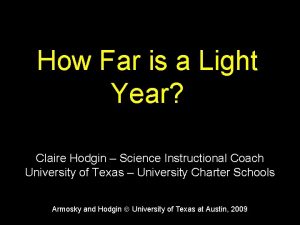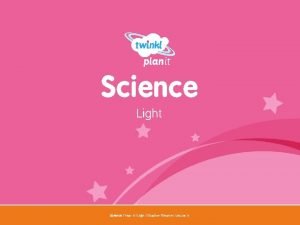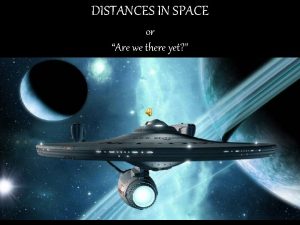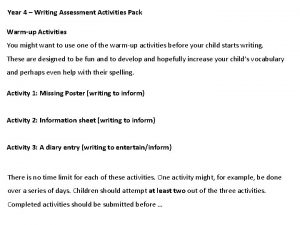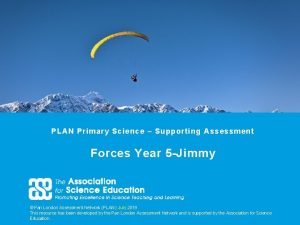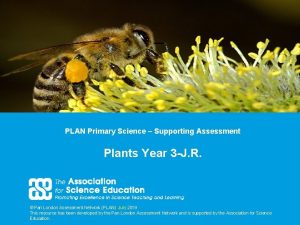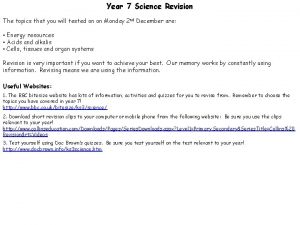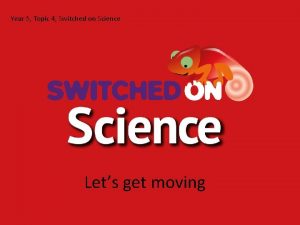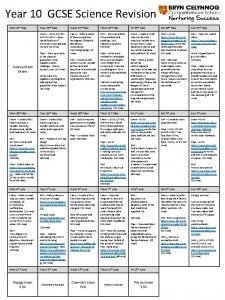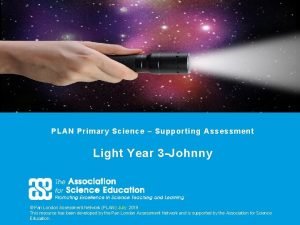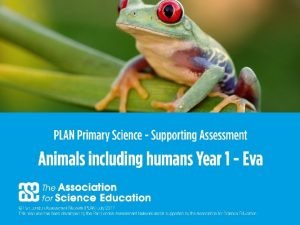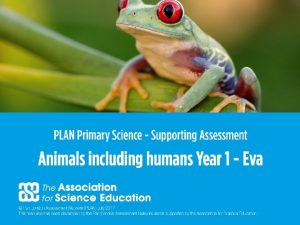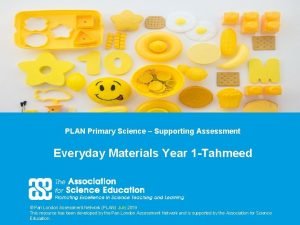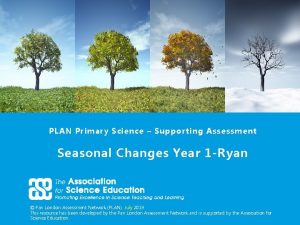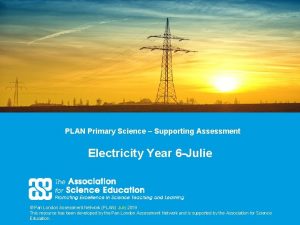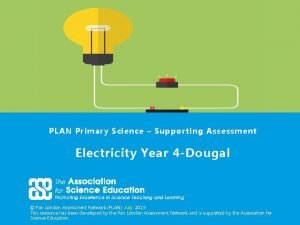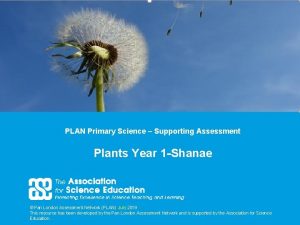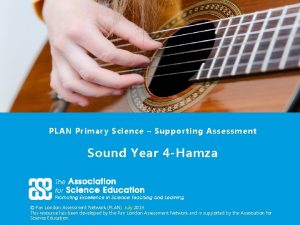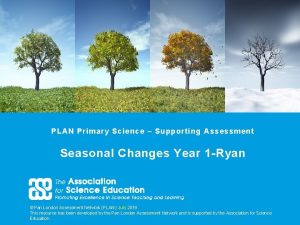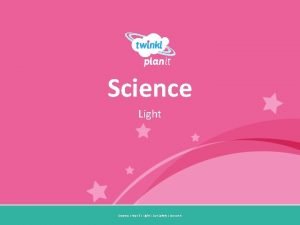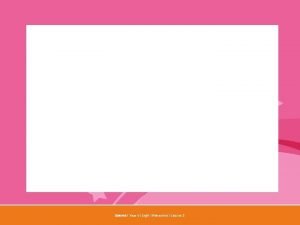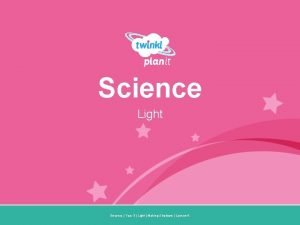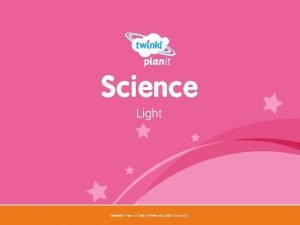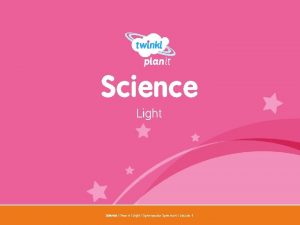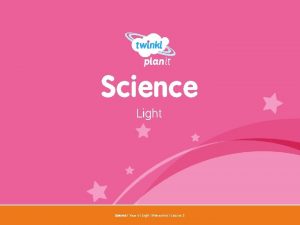PLAN Primary Science Supporting Assessment Light Year 6

























- Slides: 25

PLAN Primary Science – Supporting Assessment Light Year 6 -Muharem © Pan London Assessment Network (PLAN) July 2019 This resource has been developed by the Pan London Assessment Network and is supported by the Association for Science Education. 1

PLAN Primary Science - Supporting Assessment PLAN Primary Science is a set of resources produced to enable teachers to have a clearer understanding of National Curriculum expectations for meeting the standard. Annotated collections of children’s work provide examples of what working at the expected standard for primary science might look like for the knowledge and conceptual understanding statements of the programmes of study (POS). It is not the intention of these resources to specifically exemplify the working scientifically statements. However, aspects of working scientifically have been shown as an integral part of the teaching and learning of the knowledge and concepts. The resources provided have been cross moderated multiple times before publishing so that they can be used with confidence by teachers and subject leaders. Each collection of work shows one example of how a pupil has met National Curriculum statements for a particular area of content but these are not intended to be the definitive way of teaching these statements. 2

Structure of the resources Each resource contains the relevant National Curriculum statements for the unit of work and prior learning, a planning matrix, annotated work and a summary sheet. The matrix provides an interpretation of the key learning of the National Curriculum statements, and suggestions of key vocabulary. In order to be meet the expectations pupils must firstly understand the key concept and then be provided with opportunities to apply that knowledge. This is a key planning tool. Key Learning Secure Possible Evidence Show understanding Overview paragraph describing of a concept by curriculum using scientific vocabulary correctly Key vocabulary – list of words Possible ways to demonstrate key learning, particularly correct usage of vocabulary Apply knowledge in Suggestions of contexts to use. familiar related contexts, including a range of enquiries Possible ways to demonstrate that a pupil has gone beyond recall of facts and can apply the key learning, for example using the vocabulary and basic principles to produce explanations, usually within Working Scientifically contexts. 3

Contents of the materials Please note: The NC statements for each topic area for the relevant year group are stated on the slide. Only the statements in bold on that slide have been exemplified. In these cases the teachers have chosen to split the statements within the topic area to teach at different times. The prior NC statements relevant to the topic area are also stated and use to determine pupils’ knowledge at the start of the unit. Each slide has been annotated with coloured text. Please see key below: Red Commentary to explain how evidence meets/does not meet NC statements Blue Commentary to highlight features of working scientifically Green Pupil Speak Grey Other relevant information eg. vocabulary used 4

Year 3 Statements – Prior Learning Pupils should be taught to: • • • recognise that they need light in order to see things and that dark is the absence of light (3 -Light) notice that light is reflected from surfaces (3 -Light) recognise that light from the sun can be dangerous and that there are ways to protect their eyes (3 -Light) recognise that shadows are formed when the light from a light source is blocked by a solid object (3 -Light) find patterns in the way that the size of shadows change. (3 -Light) 5

Year 6 Statements Pupils should be taught to: • • recognise that light appears to travel in straight lines (6 -Light) use the idea that light travels in straight lines to explain that objects are seen because they give out or reflect light into the eye (6 -Light) explain that we see things because light travels from light sources to our eyes or from light sources to objects and then to our eyes (6 -Light) use the idea that light travels in straight lines to explain why shadows have the same shape as the objects that cast them. (6 -Light) 6

Later Statements Pupils do not need to be taught content they will learn in later year groups. They can be challenged by applying the content for their year group in broader contexts. Pupils in Key Stage 3 will be taught about: • the similarities and differences between light waves and waves in matter • light waves travelling through a vacuum; speed of light • the transmission of light through materials: absorption, diffuse scattering and specular reflection at a surface • use of ray model to explain imaging in mirrors, the pinhole camera, the refraction of light and action of convex lens in focusing (qualitative); the human eye • light transferring energy from source to absorber leading to chemical and electrical effects; photo-sensitive material in the retina and in cameras • colours and the different frequencies of light, white light and prisms (qualitative only); differential colour effects in absorption and diffuse reflection.

Assessment guidance Shows understanding of a concept using scientific vocabulary correctly Applying knowledge in familiar related contexts, including a range of enquiries Key learning Evidence Light appears to travel in straight lines and we see objects when light from them goes into our eyes. The light may come directly from light sources but for other objects some light must be reflected from the object into our eyes for the object to be seen. Objects that block light (are not fully transparent) will cause shadows. Because light travels in straight lines the shape of the shadow will be the same as the outline shape of the object and the size of the shadow is larger when the light source and object move closer to each other as more of the light is blocked. Key vocabulary: Straight lines, Light rays. (Y 3 vocabulary - Light, Light source, Dark, Absence of light, Transparent, Translucent, Opaque, Shiny, Matt, Surface, Shadow, Reflect, Mirror, Sunlight, Dangerous) Can describe with diagrams, as appropriate, how light travels in straight lines either from sources or reflected from other objects into our eyes. Can describe with diagrams, as appropriate, how light travels in straight lines past translucent or opaque objects to form a shadow of the same shape. Observe objects in different lighting conditions – using light from sources that can be moved, reflected and blocked in different ways. Observe shadows of different objects as the object and the light source are moved so that the distance between them and their distance from the surface where the light is falling changes. Predict or explain some uses or behaviours of light, reflection and shadows such as periscope design, shadow puppets, bending of light in water. Can predict and explain with diagrams or models, as appropriate, how the path of light rays can be directed by reflection to be seen, for example, reflection in car rear view mirrors or in a periscope. Can predict and explain with diagrams or models, as appropriate, how the shape and size of shadows can be varied.

Before starting the initial assessment activity to find out what the children already knew about light, they were given an opportunity to explore using torches to make shadows. Children were given a range of different materials and encouraged to make and change shadows. Muharem showed his understanding of the following idea • recognise that shadows are formed when the light from a light source is blocked by a solid object (year 3) • find patterns in the way that the size of shadows change (year 3) by choosing suitable materials and making different sized shadows using the same puppet. 9

Initial assessment activity – to check on previous learning from year 3 The children discussed this Concept Cartoon which addresses • recognise that they need light in order to see things and that dark is the absence of light (Year 3) The teacher asked Muharem to record in writing what he had shared during the discussion, as he had demonstrated a good understanding verbally This writing shows that Muharem is secure on the year 3 statement that light is required in order to see things. It was not essential for the child to record in writing as the teacher had been able to listen to the discussion and judged Muharem to be secure in his 10 understanding.

Initial assessment activity – to gauge starting point of new learning in year 6 • explain that we see things because light travels from light sources to our eyes or from light sources to objects and then to our eyes This evidence shows that Muharem has some understanding of light travelling in straight lines and how we see objects. He is drawing straight lines to represent the light but at the moment they do not show the path of the light clearly. This needs further work. At present his understanding is not secure. When asked how he knew this, he said that he had read it in a book and could not give any evidence to support this thinking. He needs to gather evidence so that he can use this as part of his explanation. Straight line arrows are drawn to show light. This shows an understanding that light is reflected off objects and then into our eyes which is how we see them. However reflection is not shown accurately because the arrows do not touch the object. Not clearly expressed This drawing shows understanding that there is a link between our eyes and our brain (beyond year 6 curriculum) 11

Using a hose pipe to show that light travels in a straight line • recognise that light appears to travel in straight lines A length of hose pipe has a piece of coloured acetate over one end acting as a filter. Light from a torch is shone down the hose pipe onto a table. When the hose pipe is bent no coloured light comes out of the end of the hose pipe. When the hose pipe is straight, coloured light is seen on the table, which has travelled through the hose pipe. Muharem is able to demonstrate that light travels in a straight line, as shown in video clip. 12

Using a hose pipe and a mirror to show that light travels in a straight line • recognise that light appears to travel in straight lines Through practical enquiry Muharem has used his observations as evidence for light travelling in a straight line. These two diagrams show what he means in the text above but the light is drawn outside of the hose and again is not a continuous line. Key vocabulary: reflected The children explore using lasers and mirrors. This allows them to see clearly that the light travels in straight lines and is reflected off the mirror. This is the first time Muharem has drawn the light as a continuous line. It also shows clearly how it is reflected off the surface at a single point 13

Using mirrors to show that light travels in a straight line • recognise that light appears to travel in straight lines The teacher needs to have a conversation with Muharem to find out why he is adding the extra arrows. Again. Muharem is drawing the light as a continuous straight line reflecting off the surface at a single point, now with an arrow to indicate direction. He still feels the need to additional arrows around the outside. Muharem knows that because light travels in a straight line he can reflect light in a predictable direction using mirrors. He is securely demonstrating that light travels in straight lines. Key vocabulary: reflect 14

Assessment activity - How do you think we see light sources? • use the idea that light travels in straight lines to explain that objects are seen because they give out [or reflect] light into the eye This shows that Muharem understands that we see a light source because light travels from it in a straight line into our eyes. Rays of light are drawn coming from the light source to the eye The children were shown a light source (a candle) and asked to draw how they think they see light sources using their learning about light and how it travels. Muharem chose to use the sun as his light source. 15

Exploring how we see non light sources using a black cylinder • use the idea that light travels in straight lines to explain that objects are seen because they give out or reflect light into the eye The children were given a black cylinder to look into with the base on the table. They could see nothing inside. When they shone a torch in a small hole on the side they could see the table. Muharem’s diagram now shows only one continuous straight line for the light which is reflected on a surface at a point. T: What is this arrow? M: Me, looking. The right hand diagram again demonstrates that Muharem understands that light travels in a straight line and is reflected from surfaces into the eye so he can see them. Key vocabulary: light sources, reflect 16

Consolidating and assessing learning in a piece of writing linked to ICT • use the idea that light travels in straight lines to explain that objects are seen because they give out or reflect light into the eye • explain that we see things because light travels from light sources to our eyes or from light sources to objects and then to our eyes Muharem expressed clearly in words and diagrams how we see light sources and non light sources. Additional learning beyond the KS 2 curriculum Key vocabulary: light source and light rays The lines are not continuous here but when asked he stated that he couldn’t join them on the computer. He has however demonstrated this more than once in his 17 own drawings

Investigating how shadow size can be changed • recording data and results of increasing complexity using scientific diagrams and labels, classification keys, tables, scatter graphs, bar and line graphs This activity was planned to provide an opportunity for children to develop their working scientifically skills whilst revisiting changing shadows which was covered in year 3. The children discussed the Concept Cartoon and decided how to gather evidence to justify their prediction. 18

Investigating how shadow size can be changed • recording data and results of increasing complexity using scientific diagrams and labels, classification keys, tables, scatter graphs, bar and line graphs Children collected and recorded data in different ways. This is how Muharem decided to record the data. The aim of this part of the lesson was for children to decide for themselves how to record their data. In groups the children discussed how to carry out the investigation in order to gather sufficient data. This did not need to be formally recorded as it was not the objective of the lesson. Table produced by a different child showing that they chose to measure and record the data in a different way 19

Investigating how shadow size can be changed (continued) • recording data and results of increasing complexity using scientific diagrams and labels, classification keys, tables, scatter graphs, bar and line graphs Graph produced by a different child showing that they drew their graphs Children presented independently the data in line graphs. They were expected to draw their own graphs independently. This is how Muharem presented his results 20

Investigating how shadow length can be changed (continued) • reporting and presenting findings from enquiries, including conclusions, causal relationships Muharem is able to comment on the main pattern in the data but only explicitly gives one set of results, which does not completely back the statement up with data. This is only a partial conclusion as no scientific explanation is given. This other child gives two pieces of data as evidence for the pattern. This also goes on to give the scientific reason. This is a good conclusion. 21

Exploring the shape of shadows • use the idea that light travels in straight lines to explain why shadows have the same shape as the objects that cast them. This shows a good understanding of how shadows are formed which was developed in year 3, but now the key vocabulary light ray is included and the diagram shows light travelling in straight lines. Children explored making shadows using their hands and other objects and were asked to draw diagrams to explain their observations using their knowledge of light and how it travels. An example form another child’s work which is very different showing that the work was independent and not overly structured by the teacher 22

Muharem’s text is confused but the diagrams clearly show that the child is able to use the idea of light rays to explain why are shadow changes size when the object is moved. This is beyond the KS 2 curriculum which only expects children to link this to the shape of the object but confirms understanding of light traveling in straight lines. 23

Overall Summary Secure Following a range of practical exploration Muharem has demonstrated that light travels in a straight line and talked about this confidently. He shows in his diagrams that he understands that light travels from a light source, reflects off objects and into our eyes, enabling us to see things. He explored shadows on several occasions and each time linked the formation of shadows back to the fact that light travels in a straight line. 24

Acknowledgements Slides 9 & 17 Concept Cartoons , Millgate House Publishers 25
 Light assessment year 6
Light assessment year 6 Year 3 light science
Year 3 light science Light light light chapter 23
Light light light chapter 23 Into the light chapter 22
Into the light chapter 22 Chapter 22
Chapter 22 Science experiment risk assessment
Science experiment risk assessment Plan primary science
Plan primary science Plan primary science
Plan primary science Plan primary science
Plan primary science Digestive parts
Digestive parts Plan primary science
Plan primary science Science is my favourite subject
Science is my favourite subject Fixation omission emphasis
Fixation omission emphasis Primary and supporting instruments
Primary and supporting instruments Poem leaving school
Poem leaving school 1 light year in km
1 light year in km Calculation of light year
Calculation of light year How far is a light year?
How far is a light year? Light year 6
Light year 6 How many au's in a light year
How many au's in a light year Writing assessment year 4
Writing assessment year 4 Year 5 forces assessment
Year 5 forces assessment Plants year 3 science
Plants year 3 science Year 7 science revision
Year 7 science revision Switched on science
Switched on science Year 10 science revision
Year 10 science revision
